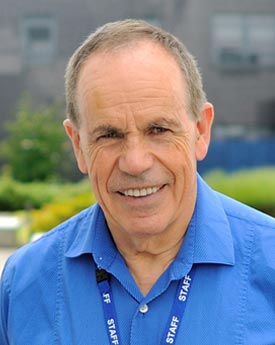
Professor Steve Long is a global leader in photosynthesis research. He is the Director of RIPE-“Realizing Increased Photosynthetic Efficiency for improved crop production” a $25M Bill and Melinda Gates Foundation project, and with over 400 publications, is listed by Thomson-Reuters as one of the Most Highly Cited Authors of 2016. He also discovered the most productive land plant known (Echinochloa polystachya).
His expertise in in-silico crop design and field analysis, and interest in global atmospheric change has driven much work towards engineering improved photosynthesis for more efficient plants with improved yield that can mitigate climate change impacts. He was instrumental in the development of SoyFACE to evaluate the impact of future climatic conditions on crops.
His work modelling photosynthesis, to show that increasing the speed at which leaves adapt to shade could potentially raise crop yields, and its demonstration in field trials, was listed as one of the 12 Key Science Moments of 2016 in The Guardian.
He has given invited briefings on bioenergy, climate change impacts and food security to President Bush at the White House, to the Vatican and to Bill Gates.
Steve Long holds the Inkenbery endowed Chair of Plant Biology and Crop Science at the University of Illinois (USA) and is a distinguished professor of Crop Science at Lancaster University (UK). He is Founding and Chief Editor of “Global Change Biology” and also founded “GCB Bioenergy”.
Title: Enhancing and Adapting Photosynthesis for Food Security.
Webinar date: Tuesday 4th October 2022 14.00 CET
Abstract: After several years in which global food supply has improved, shortages are now re-emerging. This increases the probability of repetition of the high food prices of 2007/8 that triggered food riots in many poor countries and possibly the Arab Spring. The United Nations Food & Agricultrual Organization project a worsening situation with global demand for our major crops rising 60% by 2050. This is at a time when the steady increases in yield seen over the second half of the last century are stagnating, or even reversing, under global climate change. The approaches of the Green Revolution are approaching their biological limits, and new innovations are urgently needed if we are to insure against future shortages. It will be shown that improvement of photosynthetic efficiency is the largest remaining opportunity to increase genetic crop yield potential. Its efficiency in crops falls well below the theoretical maximum and has been improved little by centuries of selection and breeding; the reasons for which will be explained. Today photosynthesis is the best understood of all plant processes, allowing us to describe each of its 100+ steps mathematically. Using this as the basis of in silico engineering using high-performance computing we have identified a number of points at different levels of organization from metabolism to organization of leaves in field crops where efficiency could be improved. This includes both adaptation to rising temperature and changing water availability. Bioengineering has begun to validate a number of these suggested improvements with substantially greater crop productivity demonstrated in replicated field trials. This will be illustrated with some specific examples, including improvement of the speed with which crop leaves relax non-photochemical quenching (NPQ) during the frequent sun to shade transitisons that occur in crop canopies. We have now shown that accelerating this relaxation can increase the yield of soybean, in replicated field trials, by >20%, which compares to a ca. 1% p.a. increase achieved by conventional breeding. This proves the potential of transgenic manipulations of photosynthesis to deliver unprecedented and much needed yield jumps. Our theoretical analyses suggest that such engineering could lead to a >50% sustainable improvement in crop yield potential so providing insurance against future food shortage and avoiding yet further agricultural expansion and destruction of natural areas.